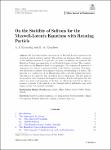Search
Author
- Carlos, Alegría (2)
- Carlos, Seara (2)
- David, Orden (2)
- Klaus, Bretterbauer (2)
- next >
Subject
Date issued
Has File(s)
- true (287)
Search Results
The paper deals with the unpublished survey and geometric analysis of the circular helical staircase built around 1660 in Palazzo Spada’s wing on Via del Polverone in Rome. Its role in the development of the place and the history of its design process are addressed thanks to historical drawings and the reference model proposed both in the treatise and construction between the fifteenth and seventeenth centuries. A description of the 3D digital survey procedures is followed by the reconstruction of a NURBS 3D model that describes the staircase and its geometric properties. |
This research concerns stereotomy in Baroque architectural theory. Specifically, it explores French influence on Guarino Guarini’s theory of stereotomy. The research argues that the French influence on Guarini’s theory of stereotomy was limited. The argument is sustained by the scarcity of references to French sources in Guarini’s theory of stereotomy. |
Aggregation equations, such as the parabolic-elliptic Patlak–Keller–Segel model, are known to have an optimal threshold for global existence versus finite-time blow-up. In particular, if the diffusion is absent, then all smooth solutions with finite second moment can exist only locally in time. Nevertheless, one can ask whether global existence can be restored by adding a suitable noise to the equation, so that the dynamics are now stochastic. Inspired by the work of Buckmaster et al. (Int Math Res Not IMRN 23:9370–9385, 2020) showing that, with high probability, the inviscid SQG equation with random diffusion has global classical solutions, we investigate whether suitable random diffusion can restore global existence for a large class of active scalar equations in arbitrary dimensi... |
In this paper, we prove uniform error bounds for proper orthogonal decomposition (POD) reduced order modeling (ROM) of Burgers equation, considering difference quotients (DQs), introduced in Kunisch and Volkwein (Numer Math 90(1):117–148, 2001). In particular, we study the behavior of the DQ ROM error bounds by considering L2(Ω) and H10(Ω) POD spaces and l∞(L2) and natural-norm errors. We present some meaningful numerical tests checking the behavior of error bounds. |
We prove the stability of solitons of the Maxwell–Lorentz equations with extended charged rotating particle. The solitons are solutions which correspond to the uniform rotation of the particle. To prove the stability, we construct the Hamilton–Poisson representation of the Maxwell–Lorentz system. The construction relies on the Hamilton least action principle. The constructed structure is degenerate and admits a functional family of the Casimir invariants. This structure allows us to construct the Lyapunov function corresponding to a soliton. The function is a combination of the Hamiltonian with a suitable Casimir invariant. The function is conserved, and the soliton is its critical point. The key point of the proof is a lower bound for the Lyapunov function. |
This paper studies convex generalized Nash equilibrium problems that are given by polynomials. We use rational and parametric expressions for Lagrange multipliers to formulate efficient polynomial optimization for computing generalized Nash equilibria (GNEs). The Moment-SOS hierarchy of semidefinite relaxations are used to solve the polynomial optimization. Under some general assumptions, we prove the method can find a GNE if there exists one, or detect nonexistence of GNEs. Numerical experiments are presented to show the efficiency of the method. |
We consider the bond percolation problem on a transient weighted graph induced by the excursion sets of the Gaussian free field on the corresponding cable system. Owing to the continuity of this setup and the strong Markov property of the field on the one hand, and the links with potential theory for the associated diffusion on the other, we rigorously determine the behavior of various key quantities related to the (near-)critical regime for this model. In particular, our results apply in case the base graph is the three-dimensional cubic lattice. They unveil the values of the associated critical exponents, which are explicit but not mean-field and consistent with predictions from scaling theory below the upper-critical dimension. |
We explore the separability of point sets in the plane by a restricted-orientation convex hull, which is an orientation-dependent, possibly disconnected, and non-convex enclosing shape that generalizes the convex hull. Let R and B be two disjoint sets of red and blue points in the plane, and O be a set of k≥2 lines passing through the origin. We study the problem of computing the set of orientations of the lines of O for which the O-convex hull of R contains no points of B. For k=2 orthogonal lines we have the rectilinear convex hull. |
This research reflects on using mathematics for processing and interpreting data obtained from digital surveying. The experiments outlined in this study demonstrate how mathematical algorithms, which can be written in computational environments like Wolfram Mathematica, can reveal the geometric structure of an architectural artifact. |
We study optional projections of G-adapted strict local martingales on a smaller filtration F under changes of equivalent martingale measures. General results are provided as well as a detailed analysis of two specific examples given by the inverse Bessel process and a class of stochastic volatility models. This analysis contributes to clarify the absence of arbitrage opportunities of market models under restricted information. |










